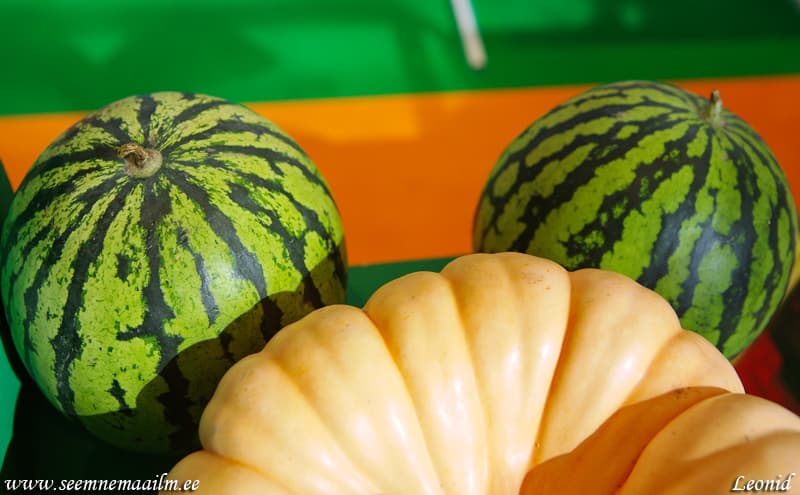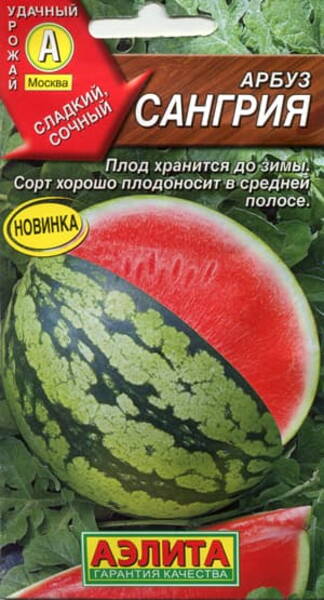Mid-season variety, ripening 80-85 days after germination. Fruits well in cool climates, producing 2-3 fruits.
The fruits are spherical, striped, weighing 3-6 kg. The pulp is red, very juicy, sugary and sweet.
The berries retain commercial quality for about 100 days after picking and tolerate transportation well.

* An effective method for obtaining early watermelon production is the seedling method.
Thanks to the boost in plant development obtained by growing seedlings this way, it is possible to collect the first fruits 10 - 20 days earlier than when sowing seeds in the ground. At the same time, the early harvest increases several times, and the overall fruit yield also increases significantly. Watermelon seedlings are grown in semi-warm, early greenhouses or film greenhouses as a second crop after green vegetable crops or early cabbage seedlings.
You can grow it at home - in a room on window sills and balconies. Seedlings are grown in nutrient pots of the same composition as for vegetable crops, in paper cups measuring 8x8 or 10x10 cm. The age of the seedlings is 30 - 35 days (from emergence). Before planting, seedlings are watered abundantly, and water is also added to the holes when planting seedlings. It is planted according to the same scheme as when sowing seeds in the ground. Subsequent care for planted plants is the same as for seeded ones.
Fruit harvesting.
Watermelon fruits are usually harvested as they ripen. In this case, fruits intended for transportation over long distances are harvested several days before full ripening, and those used at the production site and seed fruits are harvested in the full ripening phase. The final, continuous collection of ripe fruits promotes better growth and ripening of the remaining fruits. Therefore, it is impossible to be late (as well as to rush) in harvesting fruits. Experienced melon growers determine the maturity of watermelon fruits visually by their appearance.
When ripe, watermelon fruits acquire the shine and elasticity of the bark characteristic of each variety, the clarity of the color of the bark and the pattern on it, form a yellow spot on the area of the bark lying on the ground, the stalk and tendril near it dry out when the fruit ripens, when you hit the ripe fruit with your palm or when it clicks, it makes a dull sound, and when you squeeze it (which is not recommended), you can hear the crackling sound of the pulp...
Placement of crops.
Watermelon (as well as other melons) gives the best results when sown on virgin and fallow lands or after perennial grasses, which are the best predecessors for them. On personal plots (especially in areas with insufficient heat), areas that are well heated by the sun, with a southern, southeastern or southwestern slope, are selected for watermelon. It can also be grown in hotbed areas and between the rows of young gardens that are not shaded by garden plantings.
Application of fertilizers.
The most effective combination of mineral and organic fertilizers. From organic matter, it is best to add rotted last year's manure or humus to the watermelon. Fresh manure, especially in large doses, worsens the taste of fruits and weakens plant resistance to disease. It is advisable to apply it under watermelon only in the northern cultivation areas in small areas, where it is used not so much as a fertilizer, but to insulate the soil and enrich the soil and air with carbon dioxide, i.e. to improve the microclimate. In this case, manure is applied in the spring into pre-made furrows or pits (steam pits), then covered with earth in a layer of 10-15 cm, and in steam pits - 15-20 cm.
Watermelon seeds are sown on the side along the furrows or in the middle of the steam pit. You can make ridges 210 - 270 cm wide, add manure and cover it in the furrow in the middle of the ridge (alongwise) and sow two rows of watermelon on the ridge on the sides of the furrow with the covered manure. The width of row spacing on a ridge is 70-90 cm, and between rows on adjacent ridges is 140 - 180 cm. Manure consumption when using these techniques is approximately 6-8 kg per 1 sq. m. m. Of the mineral fertilizers for watermelon, it is best to apply superphosphate, ammonium nitrate and potassium salt. It is necessary to take into account that an excessive amount of nitrogen fertilizers negatively affects the taste and dietary qualities of watermelon fruits, in particular, it leads to the accumulation of nitrates harmful to humans. Therefore, you should not abuse the use of nitrogen and other types of fertilizers, especially during the fruiting period.












